Transition between High Marsh and Forest in Mainland Marshes:
Observations in the Vicinity of Phillips Creek
Joseph I. Hmieleski and Mark M. Brinson, East Carolina University
The Issue: Rising sea level is a long-term chronic force that causes the
landward migration of mainland marshes at the VCR. Details of the
migration are depicted by a conceptual model of state changes
(Fig. 1)
beginning as a fixed site in mainland forest that eventually transforms
to a heterotrophic benthic system (Brinson et al. in review). We examine
the spatial arrangement between two states - the transition between
forest and high marsh - as a basis for developing hypotheses on how
changes might occur over time (Hmieleski 1994).
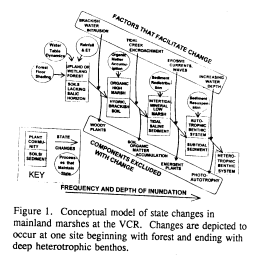
The literature on rising sea level and its influence on migrating
marshes suggests that the rate of lateral movement will be inversely
proportional to slope of the landward surface (Titus 1987). This logic
holds until slopes become so diminished that they are virtually flat. In
such cases, landward migration should occur instantaneously once sea
level reaches a threshold appropriate to cause flooding on the flat
surface. This is unlikely to take place, however, because distance
itself becomes a dominant factor in modulating marsh migration over
relatively flat slopes. Resistance to overland flow from tidal sources
will limit the transport saline water landward. Stated differently,
slope must be taken into consideration when predicting the rate of marsh
migration and the elevation occupied by the transition zone.
Approach: Elevation and distance from a source of salt water are both
variables of slope that should be examined independently for their
influence on overland migration of marshes. The forest-high marsh
transition is the leading front of migration. To examine how the
forest-high marsh transition varies with slope and elevation, we
installed four transects across transition zones shown in
Fig. 2 as
combinations of steep slope, flat slope, near to a tidal creek, and far
from a tidal creek. Details of sampling points and representative
distances are shown in
Fig. 3. Linear regressions were used to determine
overall slope for each of the transects (Fig. 4).
For the flat
transects, microtopographic relief determined over 2 m intervals
normally exceeded differences in macrotopography across entire
transects. Transition zones were identified from changes in species
composition of vegetation . In contrast to high marsh which is dominated
by Spartina patens and Distichlis spicata,
the transition zone contains
shrubs, small trees, and graminoids (Juniperus virginiana, Baccharis
hamilifolia, Ilex opaca, Iva frutescens, and Panicum virgatum).
The forest landward of the transition zone is dominated by Pinus taeda
individuals that are considerably larger than the few stunted
individuals occurring in the transition zone.
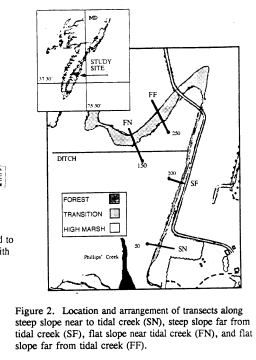
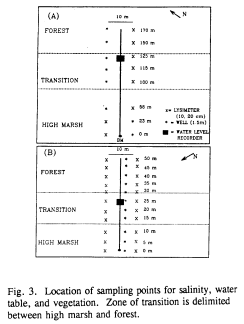
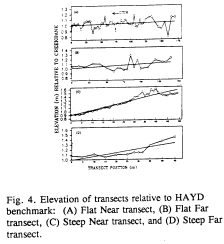
Mean elevations of the high marsh, transition, and forest portions
of the transects show that elevations in the transition zone and forest
zone are significantly higher on steep transects than they are on flat
transects (Fig. 5). Mean elevations of the
high marsh did not differ
among transects. Depths to water tables were also greater for steep
slopes (Fig. 6).
Mean pore water salinities at 10 and 20 m depth were
significantly higher for the flat than the steep transect. Even the
pattern of salinity showed greater variation in the steep than the flat
slope (Fig. 7).
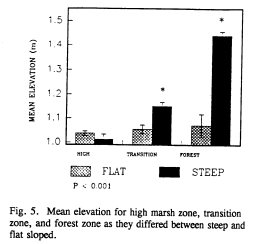
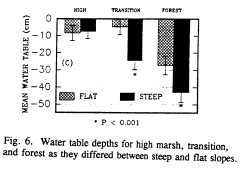
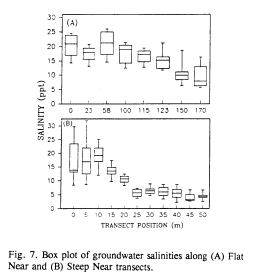
Conclusions: Previous studies have concluded that slope is an important
variable in the rate of landward transgression of salt marshes. However,
distance becomes important in determining the elevation at which the
transition of vegetation will occur. Presumably it also influences the
rate of movement of the leading front. Flat slopes are occupied by
transitional vegetation at lower elevations than with steeper slopes.
Consequently, the elevation of the transition zone of vegetation varies
depending on whether the process occurs on a steep or relatively flat
slope.
An understanding of the transition from forest to high marsh is
critical because it occurs on and modifies the same geomorphic surface
that will be occupied by subsequent changes in state including
intertidal low marsh and subtidal lagoon. The transition has
socioeconomic implications for land use. The forest-high marsh
transition is the first that renders land effectively useless for most
silviculture, agriculture, and urbanization.
References:
Brinson, M.M., R.R. Christian, and L.K. Blum. In review. Multiple states
in the sea-level induced transition from terrestrial forest to estuary.
Estuaries
Hmieleski, J. I. 1994. High marsh-forest transitions in a brackish
marsh: The effects of slope. Master's thesis, East Carolina University,
Greenville, North Carolina. 129pp.
Titus, J. G. 1987. The greenhouse effect, rising sea level and coastal
Wetlands. EPA-230-05-86-013. Office of Policy, Planning and Evaluation,
Environmental Protection Agency, Washington, D.C. 152 pp.






